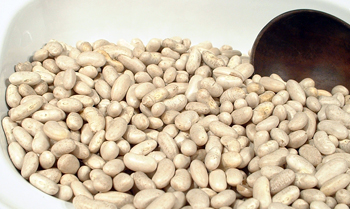 White Kidney Beans
White Kidney Beans© Denzil Green
White Kidney Beans are white coloured beans shaped like a kidney. They are closely related to red kidney beans. They have a somewhat milder flavour than the red beans, with a hint of slight sweetness to the taste. Like red kidney beans, they are about ½ inch long (1 cm) dried. Their shape is only vaguely suggestive of a kidney, and even that tends to vanish as the beans plump up through soaking and cooking. And, like red kidney beans, they have the same creamy texture when cooked and mashed.
These beans are now very traditional in Italy, especially in Tuscany. You will often see them at stores referred to by their Italian name, “Cannellini.”
Cooking Tips
Same cooking time as for red kidney beans, about 3 hours if unsoaked, closer to 2 if soaked before cooking.
Rinse canned ones in a sieve under running water to remove sludge and some excess sodium off them.
Substitutes
Great Northern Beans
Nutrition
Kidney beans, White or Red, should never be eaten raw as they contain trace amounts of a poison that is destroyed by cooking.
Equivalents
1 pound (450g) dried = 2 to 2 ½ cups dried = 5 to 6 cups, boiled
1 cup of dried beans = approx 8 oz / 225g = approx 3 cups, boiled
1 cup cooked, drained = 170g = 6 oz
1 15oz / 420g tin of cooked, drained and rinsed = 1 ½ cups = 9 oz / 250g
1 19oz / 540 ml tin of cooked, drained and rinsed = 2 cups = 12 oz / 340g
History Notes
White Kidney Beans were developed in Argentina by Italian immigrants there, then the beans made their way back to Italy.
Language Notes
Cannellini means “little tubes” in Italian, possibly referring to their plump, elongated shapes when cooked.
Sources
Lancaster, Bridget. Learn to Cook: How to Brine Beans. America’s Test Kitchen. 25 April 2012. Retrieved July 2012 from http://www.youtube.com/watch?v=pRDL2C6M1_o

